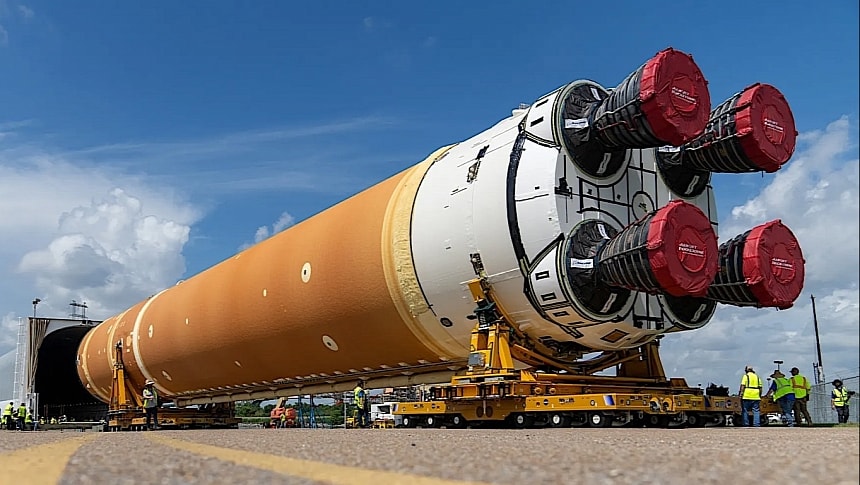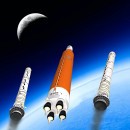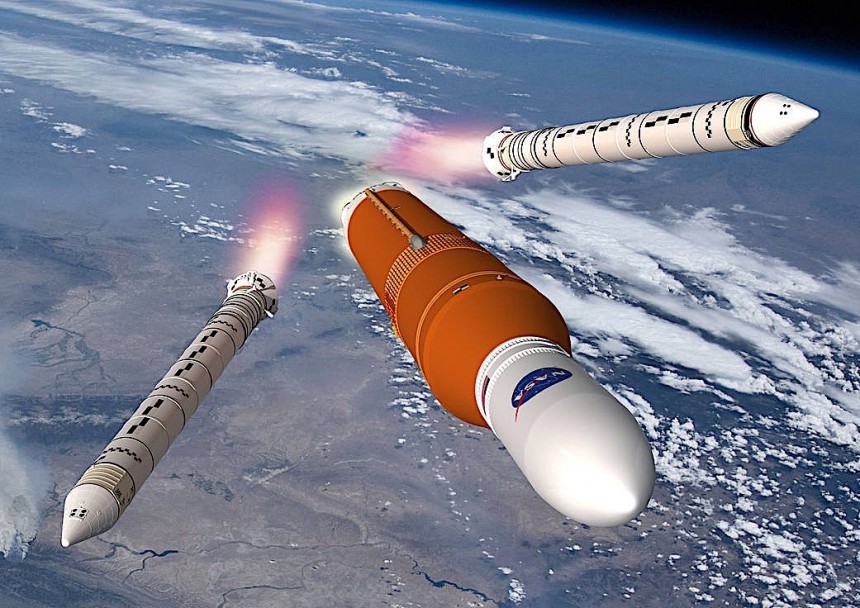The Space Launch System (SLS) rocket is big - so big, in fact, that it dwarfs everything that came before it. But one doesn't really get a sense of that until a bunch of humans are standing next to it. And that's exactly what the space agency showed us this week.
The SLS is the heart that will power the Artemis Moon exploration program. Already flown in the first mission that departed empty back in 2022, the rocket is now getting ready to transport a crew of four people (Reid Wiseman, Victor Glover, Christina Hammock Koch, and Jeremy Hansen) on a trip around the Moon.
The mission is called Artemis II, and it is presently scheduled to leave the pad sometime next year. It will carry the astronauts, including the first person of color and the first woman, to the farthest point from home humans have ever been (6,400 miles/10,300 km beyond the Moon) and then safely bring them back home, proving all systems are go for landing during Artemis III.
Whereas most of the mission will be performed by the spacecraft known as Orion, the departure from Earth would not be possible without the SLS rocket. Comprising a core stage fitted with four Space Shuttle engines and two solid-fueled booster rockets, the SLS is capable of developing a combined 8.8 million pounds of thrust.
All of that makes the SLS "the only rocket capable of carrying crew and large cargo to the moon and beyond in a single launch," as per NASA.
A good chunk of the total thrust comes from the core stage, a product of aerospace giant Boeing. The four RS-25 engines attached to it are capable of pushing against the gravity of our planet with more than 2 million pounds of thrust, which will all be unleashed in a very short timeframe of under eight minutes.
The engine can generate that by burning 733,000 gallons (almost 2.8 million liters) of super-chilled liquid propellant housed in the pair of huge propellant tanks that form two of the core stage's five main components. Together, the five elements make for a core stage structure that is 212 feet (65 meters) tall and almost 28 feet (8.5 meters) in diameter.
By all accounts, this is the largest component of the Artemis II mission and also the largest of its kind NASA has ever produced. And seeing it get moved is something of a spectacle in itself.
The SLS core stage was assembled by Boeing at the NASA Michoud Assembly Facility (MAF) in New Orleans, but from there it has to be moved to the Vehicle Assembly Building located at the Kennedy Space Center in Florida.
That's because the core stage's integration with the upper stage, the solid rocket boosters, and the Orion spacecraft will have to be performed there, close to the launch pad from where it will eventually depart.
So this is why the people working on the project began to move the core stage. On Tuesday, July 16, just as the world was celebrating the 55th anniversary of the launch of Apollo 11, the first mission that landed humans on the Moon, the SLS core stage was rolled out and shipped using specialized transporters to the Pegasus barge that will carry it to Florida.
The barge itself is something akin to a monster. It is 310 feet (94.4 meters) long and 50 feet (15.24 meters) wide, but it is unpowered, so it needs tugboats to get about its business. It will have to move the core stage 900 miles (1,450 km) to its new home. NASA did not say exactly how long the trip is expected to take, but we'll probably hear all about it when finished.
As per the agency, the move of the rocket stage marks the first time since the days of the Apollo program that the Michoud facility rolled out such a piece of hardware.
As the barge carrying the Artemis II core stage moves away from New Orleans, people there are already hard at work prepping the next generation of the SLS main component, the one meant for the Block 1B version.
These improved rockets will power the flights of the Artemis III, IV, and V missions, and the increased workload generated by them means that Boeing will have to expand assembly operations beyond Michoud. The Kennedy Space Center will also become a production hub, taking care of final assembly and outfitting activities starting with Artemis III.
The task of building the rockets for the Moon exploration program is simply daunting. All one has to do to realize that's so is look at how many entities are involved in this: aside from NASA's own centers, all ten of which are working on the program, no less than 1,100 companies across the nation are also more or less involved.
The mission is called Artemis II, and it is presently scheduled to leave the pad sometime next year. It will carry the astronauts, including the first person of color and the first woman, to the farthest point from home humans have ever been (6,400 miles/10,300 km beyond the Moon) and then safely bring them back home, proving all systems are go for landing during Artemis III.
Whereas most of the mission will be performed by the spacecraft known as Orion, the departure from Earth would not be possible without the SLS rocket. Comprising a core stage fitted with four Space Shuttle engines and two solid-fueled booster rockets, the SLS is capable of developing a combined 8.8 million pounds of thrust.
All of that makes the SLS "the only rocket capable of carrying crew and large cargo to the moon and beyond in a single launch," as per NASA.
A good chunk of the total thrust comes from the core stage, a product of aerospace giant Boeing. The four RS-25 engines attached to it are capable of pushing against the gravity of our planet with more than 2 million pounds of thrust, which will all be unleashed in a very short timeframe of under eight minutes.
By all accounts, this is the largest component of the Artemis II mission and also the largest of its kind NASA has ever produced. And seeing it get moved is something of a spectacle in itself.
The SLS core stage was assembled by Boeing at the NASA Michoud Assembly Facility (MAF) in New Orleans, but from there it has to be moved to the Vehicle Assembly Building located at the Kennedy Space Center in Florida.
That's because the core stage's integration with the upper stage, the solid rocket boosters, and the Orion spacecraft will have to be performed there, close to the launch pad from where it will eventually depart.
So this is why the people working on the project began to move the core stage. On Tuesday, July 16, just as the world was celebrating the 55th anniversary of the launch of Apollo 11, the first mission that landed humans on the Moon, the SLS core stage was rolled out and shipped using specialized transporters to the Pegasus barge that will carry it to Florida.
The barge itself is something akin to a monster. It is 310 feet (94.4 meters) long and 50 feet (15.24 meters) wide, but it is unpowered, so it needs tugboats to get about its business. It will have to move the core stage 900 miles (1,450 km) to its new home. NASA did not say exactly how long the trip is expected to take, but we'll probably hear all about it when finished.
As the barge carrying the Artemis II core stage moves away from New Orleans, people there are already hard at work prepping the next generation of the SLS main component, the one meant for the Block 1B version.
These improved rockets will power the flights of the Artemis III, IV, and V missions, and the increased workload generated by them means that Boeing will have to expand assembly operations beyond Michoud. The Kennedy Space Center will also become a production hub, taking care of final assembly and outfitting activities starting with Artemis III.
The task of building the rockets for the Moon exploration program is simply daunting. All one has to do to realize that's so is look at how many entities are involved in this: aside from NASA's own centers, all ten of which are working on the program, no less than 1,100 companies across the nation are also more or less involved.




























